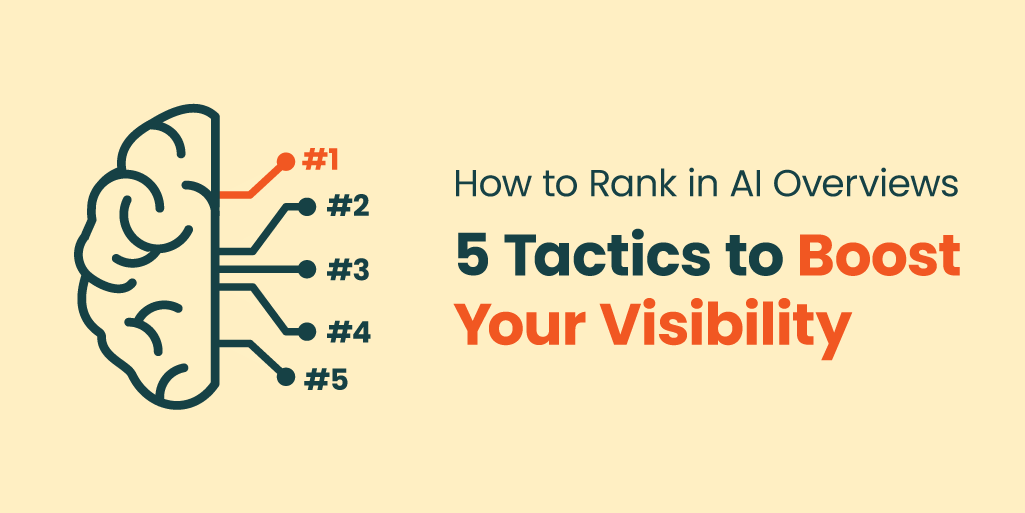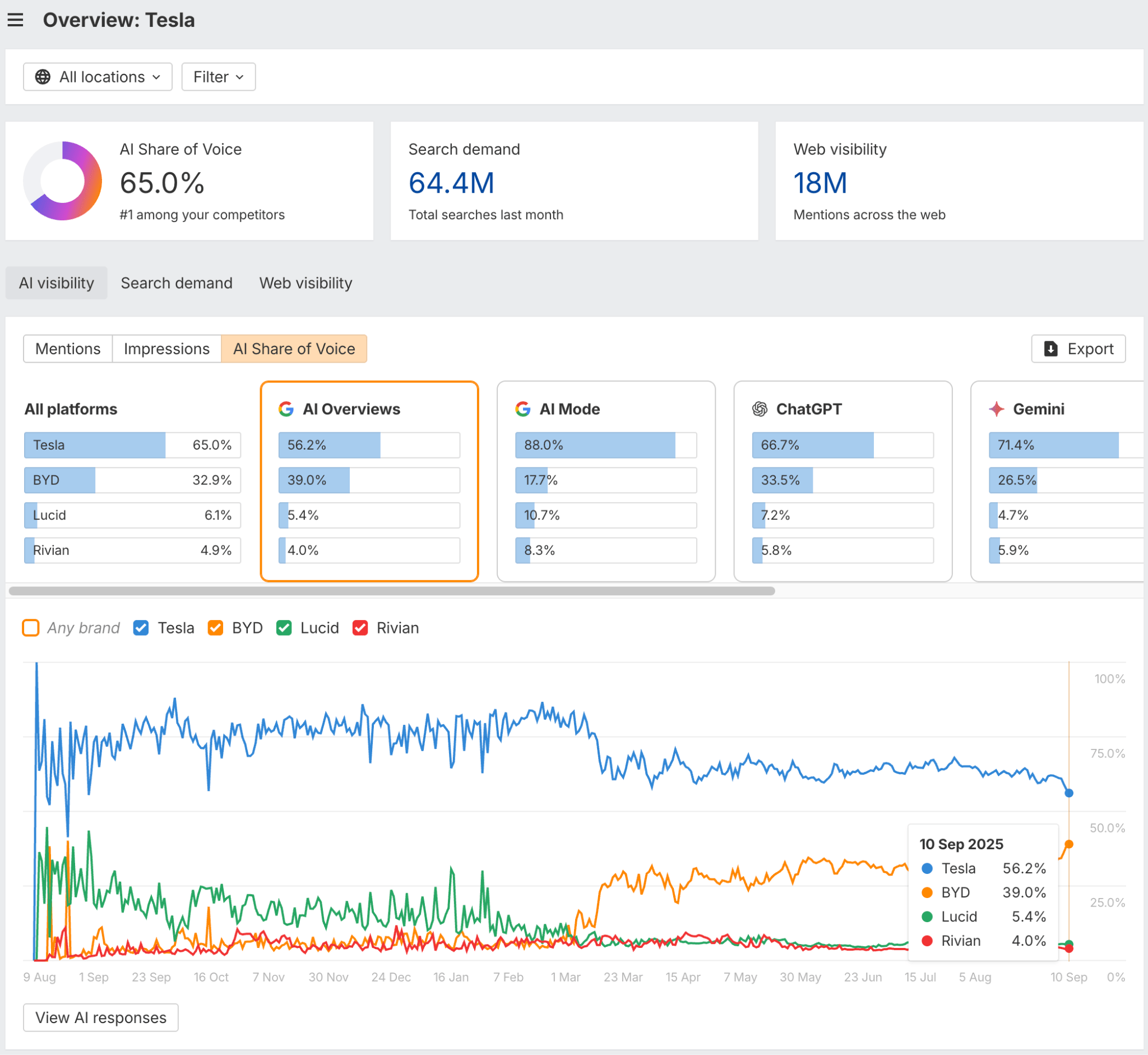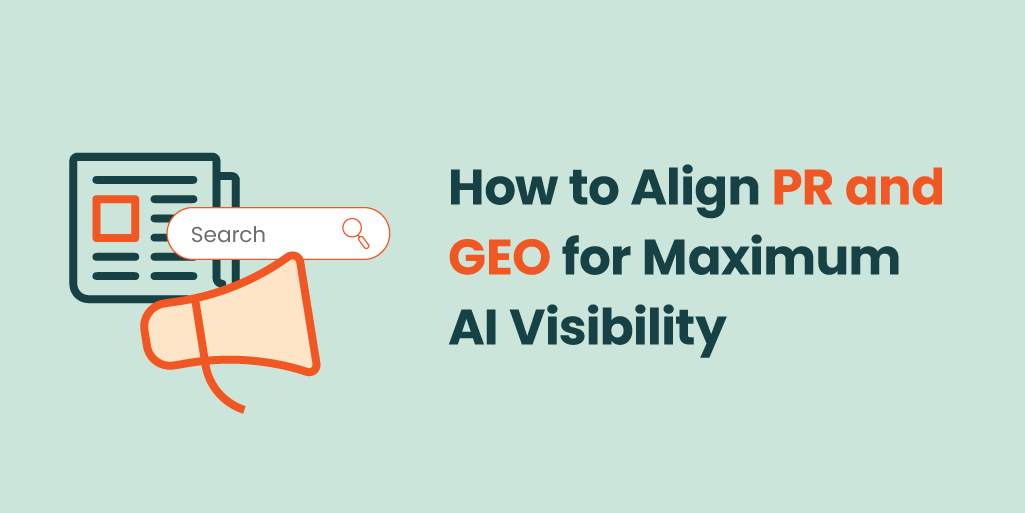Google AI Overviews (AIOs) are now becoming more widely deployed and understood as a key pillar in AI search. First introduced in the rollout of Search Generative Experience (SGE), AIOs were initially tested out in primary search results in March 2024. Originally pushed in the U.S in May 2024, “SGE” became known as AIO, with few components still remaining in the previously coined “Search Labs.” By October 2024, AIOs were pushed in over 100 countries, and today “AI Overview” has been fully deployed in over 200 countries. Recently, it is reported that AI Overviews appear in approximately 30% of all Google search results, and importantly up to 74% in question-based/informational queries.
AIOs have already made a significant impact on the organic search landscape. Most noticeably, AI Overviews have been the main driver of 0-click behavior, which has reduced organic clicks for informational queries, since users often get their answers directly in the summary without needing to visit a website. This has increased competition for inclusion, and pushing SEO toward deeper expertise, structured data, and long-tail content. While quick-answer keywords are losing traffic potential, commercial and transactional queries remain less affected, making them more valuable targets.
What is an AI Overview
AI Overviews are Google’s generative snapshots that appear at the top of search results, designed to give users a quick, conversational answer by pulling information from multiple trusted sources.
Instead of simply listing blue links, it pulls information from multiple trusted sources and uses artificial intelligence to stitch those insights together into a summary. You will find these Google AI Overviews most often above paid search ads and SERP1 results at the top of the page:
AIOs are designed to save users time by delivering key points upfront, while also offering citations and links to dive deeper into the original sourced content. In the SEO world, they have established what we know as the “position zero” result, pushing traditional SERP listings further down the page and capturing user attention first. For SEOs, this means organic search is no longer just about ranking in the top results — it’s now also about optimizing content so it can be cited or featured within the AI-generated summary.
How do Google AI Overviews Work?
AI Overviews use retrieval-augmented generation (RAG) approach to generate their summaries. Instead of answering a query from a pre-trained language model, RAG allows the system to retrieve fresh, relevant information from Google’s index and then use a generative model to summarize and synthesize it.
First, Google finds relevant, high-quality pages for a query, then the AI pulls key information from those sources and generates a clear, conversational response. This approach helps ensure that the answers are accurate and grounded in real content, while still giving users a quick summary.
This RAG method ensures AI Overviews aren’t just “hallucinating” answers from training data — they’re built on real, up-to-date content from across the web. It also means SEO still plays a direct role: if your content is relevant, trustworthy, and well-structured, it has a higher chance of being retrieved and included in the AI-generated result. Most importantly for SEOs, this means that RAG-powered AI Overviews still use traditional SERP results to generate summaries, which we will cover in greater detail below.
How to Optimize for AI Overviews: 5 Key Tactics
Now that we have established how AI Overview works, particularly with the use of SERP results in AI-generated results, it is important to dive into what is actually being cited. Recent studies have shown that 52% of AI Overviews pull information from pages that rank in the top 10 search engine page results, highlighting the importance and relevance of SERP1 keyword rankings — while also showing that top 50 ranking keywords still hold strong weight in influencing AI Overviews (48%).
In addition, it is now understood that the types of queries that trigger AI overviews are almost always ‘informational’ (keyword intent). According to this Ahrefs study, 99.2% of keywords that triggered an AI Overview were ‘Informational’. While seemingly everchanging, we use these data points as pillars of understanding when building our AIO strategy.
Let’s take a look at our 5 key tactics for AI Overviews Optimization:
1. Keyword-optimized helpful content that matches the search intent
Creating optimized content that answers common questions about the topic of your page content is at the core of showing up in AI Overviews. Google’s generative summaries are designed to surface the clearest, most useful information, which means it’s no longer enough to simply sprinkle keywords across a page. Instead, focus on building content around the questions users are actually asking and provide direct, actionable answers up front.
For example, when optimizing for informational content, target long-tail keywords as AIO’s average phrase length is four words vs. two words in non-AIO SERPs. By aligning your keyword strategy with intent — whether informational, navigational, or transactional — you not only increase your chances of being cited in AI Overviews but also improve the overall user experience on your site.
2. Build Comprehensive Topic Clusters
Leaning into optimizing informational content for AIO is critical. AI Overviews tend to favor sites that demonstrate deep, comprehensive coverage of a subject rather than isolated, single-page content. To take advantage of this, organize your content into topic clusters: a central “pillar/anchor” page that covers the main theme in depth, supported by multiple subpages (clusters) that explore related questions or subtopics. Each “cluster page” should link back to the pillar and to other relevant cluster pages, creating a clear internal linking structure that signals authority and topical relevance to Google. This is in parallel with the Pillar and Cluster strategy in SEO, however refined for AIO in page structure and content positioning.
For example, a cloud storage company could create a pillar page titled “The Complete Guide to Cloud Storage Solutions” that broadly covers types of storage, cost considerations, security, and best practices. Cluster pages might include “Comparing Public vs. Private Cloud Storage,” “How to Reduce Cloud Storage Costs,” and “Cloud Storage Security Best Practices.” When Google’s AI retrieves content for an overview, having this interconnected cluster increases the likelihood that multiple pages from your site will be cited, giving your brand greater visibility and credibility in search results.
Rather than relying on traditional “skyscraper techniques” in SEO that extensively cover a topic, ranch-style content spreads the load across many focused, interconnected articles each zooming in on specific sub-topics. Ranch-style content is often easier for large language models (LLMs) and AI Overviews to parse because each piece is more narrowly scoped and matches specific user intent. Over time, the ranch-style strategy builds topical authority by sending multiple signals (internal linking, freshness and clarity), which are important for AI optimization.
3. Improve E-E-A-T (Experience, Expertise, Authoritativeness, Trustworthiness) for AIOs
One of the most important ways to optimize for AI Overviews is by demonstrating strong E-E-A-T signals. Let’s dive into actionable E-E-A-T Tactics for AI Overview Optimization:
Here are 5 Actionable E-E-A-T Tactics in practice for AI Overview Optimization:
1. Experience: Include Real-World Examples & Case Studies
Focus on content that demonstrates real-world examples, case studies, or personal insights that show hands-on knowledge of topics in website content.
2. Expertise: Show Author Credentials
Highlight the credentials of content creators or subject matter experts — as author recognition is becoming a more important component of entity optimization, and has renewed importance in optimizing for LLMs.
3. Authoritativeness: Cite Authoritative Sources
This can be boosted through referencing original research, industry reports, or reputable publications to back up claims. Ensure links point to trusted, high-quality domains.
4. Trustworthiness: Maintain Accurate Content & Enhance Site Trust Signals
This can be strengthened over time by accurate, up-to-date content, clear sourcing, transparent authorship, and a healthy site experience (i.e secure HTTPS, strong core web vitals and easy navigation).
4. Implement Rich Schema Markup
An important but sometimes forgotten strategy in SEO now becomes more important in the world of AIO: adding structured data (schema) to your website helps Google’s AI understand your content more clearly, increasing the chances of ranking in AI Overviews. Schema provides explicit cues about the type of content, its purpose, and key attributes, which makes it easier for AI to extract and summarize information accurately.
Let’s take a look at the key types of schema to use for optimization in AI Overview with this AI Overview Schema Checklist:
✅ 1. FAQ Schema: Perfect for Q&A-style content. When used, Google can pull your questions and answers directly into overviews.
- Purpose: Highlights common questions and answers on a page.
- Use Case: Blog posts, help centers, guides.
- Example [json] markup:
✅ 2. HowTo Schema: Ideal for step-by-step guides, recipes, or tutorials. This signals the AI that your content is structured in a clear process format.
- Purpose: Structures step-by-step instructions for processes or tasks.
- Use Case: Tutorials, setup guides, recipes.
- Example [json] markup:
✅ 3. Product Schema: Highlights product details like pricing, availability, and ratings. This helps AI summaries include factual, up-to-date product information.
- Purpose: Provides product details for AI and search engines.
- Use Case: Ecommerce pages, SaaS pricing or features.
- Example [json] markup:
✅ 4. Article/News Schema: Reinforces authority by specifying the author, publication date, and headline, which is especially important for informational content.
- Purpose: Signals authorship, publication date, and content type.
- Use Case: Blogs, news, informational content.
- Example [json] markup:
By implementing these schemas in the HTML markup of your webpages, your content becomes more machine-readable and likely to be surfaced in AI-generated summaries while also improving eligibility for rich snippets and other enhanced search features.
5. Update Web Content Regularly: Now More Than Ever
Content freshness has always been an important pillar in SEO, however, now it has become even more critical in the world of AI search. Google AI Overviews favor content that is current and relevant. In fact, studies have shown that AI-cited content tends to be approximately 25.7% fresher than traditional organic search results. Regularly updating your content with the latest information, statistics, and insights signals to Google’s AI that your page remains authoritative and trustworthy. Here are some practical steps you can take to ensure your content is refreshed for AIOs:
- Regularly Review and Update Content: Establish a routine to revisit and refresh your content, ensuring it reflects the most current information and trends.
- Highlight Recent Changes: At the top of the article or in the metadata and/or schema, clearly indicate the date of the last update and any significant changes made to the content, making it easier for both users and AI to recognize its freshness.
- Incorporate Recent Data and Examples: Integrate the latest statistics, case studies, and real-world examples to enhance the credibility and relevance of your content.
- Remove Outdated Information: Regularly audit your content to eliminate obsolete or inaccurate information, maintaining the overall quality and trustworthiness of your page.
By consistently prioritizing freshness and updates, you not only improve your chances of being featured in AI Overviews but also provide valuable, up-to-date information to your audience, fostering trust and engagement.
AI Overviews Tracking: Methods and Tools
Tracking AI Overviews is crucial for understanding your content’s visibility in the evolving search landscape. While Google Search Console doesn’t provide direct data on AI Overviews rankings for your site, we have found several other tools that offer valuable insights.
1. SEMrush: SERP Snippet Feature
Our preferred tool is the Featured Snippet in SEMrush’s Search Feature Tool, which has proven to be particularly effective for monitoring a site’s rank in AI Overviews. The Guru plan allows you to see historical data on AI Overviews, and you can see AI Overview rankings in real time. Here is an example of the SERP Features dashboard reporting on AI Overviews:
In addition, another feature that makes the SEMrush SERP feature stand out as an AI Overviews rank tracker is the detailed query data on which specific keywords mapped to the specific site page that is ranking:
For more details on AI Overview tracking in SEMrush’s SERP Features, please visit this page.
2. Ahrefs: AI Overview Tracking in Site Explorer
Another great tool to track ranking in AI Overviews is the SERP Features filter in Ahrefs’ Site Explorer Tool. In Ahrefs’ Site Explorer, navigate to the Organic Keywords report and apply the “AI Overview” SERP Features filter to see which keywords trigger AI Overviews and where your pages rank.
Another method in the software is tracking how your brand is mentioned in AI Overviews by searching for your brand name in Ahrefs’ Brand Radar tool, which provides insights into the brand’s visibility and sentiment in AI-generated summaries.
Expert Support to Help You Optimize for AI Overviews
Firebrand’s expert GEO/SEO team can help you create, position and optimize your content for AI Overviews in the evolving space of AI search. Our team offers full-scale B2B GEO services to help your company get ahead of the curve and become the brand LLMs and Google’s AI trust. Simply reach out for more information based on your business-specific needs. We’re here to help you improve your AI search visibility and crush your marketing goals!
About the Author
Arman Khayyat is a Bay Area–based senior digital marketing leader and Account Supervisor at Firebrand, where he helps B2B startups and scaleups accelerate growth through performance-driven programs. He leads client programs across PPC, SEO, and marketing analytics—helping high-growth startups and enterprise tech brands scale efficiently. His expertise spans everything from paid search architecture and technical SEO audits to funnel analytics and conversion optimization.
Prior to joining Firebrand, Arman held digital marketing leadership roles at B2B technology firms and agencies, bringing over a decade of experience in growth marketing and performance media. Arman frequently writes about B2B lead generation, search strategy, and the evolving role of LLMs and Generative Engine Optimization (GEO) in discoverability. Passionate about the evolving search landscape, he’s currently exploring the impact of LLMs and Generative Engine Optimization (GEO) on organic discoverability.
Outside of work, you’ll find him experimenting with AI tools, perfecting his espresso technique, or watching is favorite sports teams.
Follow Arman on LinkedIn or explore more on Firebrand’s blog.












